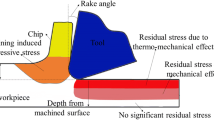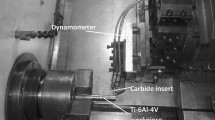Abstract
Residual stresses retained in the machined component are very crucial for the service and fatigue life of the component. Hence, it is very important to verify the residual stresses developed in the machined component while adopting any new machining or cooling technique. However, identification of residual stresses and its thorough investigation is quite cumbersome in machined component. In this work, the machining was carried out using a novel technique termed as Spot Cooled Vibration Assisted Turning (SCVAT) which is an integrated process that combines vortex tube-based spot cooling (VTSC) using CO2 gas with Vibration Assisted Turning (VAT). The nature and magnitude of residual stress induced in the machined component on its surface and along its depth was investigated while machining Ti6Al4V alloy using CFD aided FE model. Initially experiments were conducted at constant machining, vibration and flow parameters. The residual stresses were measured using x-ray diffraction technique and the same are used to validate the CFD aided Finite Element model (FE), and it was observed that the model predicts the residual stresses with acceptable accuracy. This validated CFD aided FE model was used to carry out a thorough parametric study on the influence of machining, vibration and cooling parameters on residual stress and its nature, on the surface and along the depth from the surface. The thermomechanical loading responsible for residual stress formation was studied through CFD aided FE analysis. Surface level hardness and surface topography were observed for the samples to understand the surface integrity. The results are better than conventional turning, VAT and VTSC. SCVAT is able to develop compressive residual stresses of higher magnitude than its counterparts. Application of lower cutting speed, higher amplitude of vibration, less nozzle tool distance and nozzle diameter, high coolant pressure and cold fraction are able to induce compressive residual stresses.




















Similar content being viewed by others
References
A. Pramanik, Problems and Solutions in Machining of Titanium Alloys, Int. J. Adv. Manuf. Technol., 2014, 70(5–8), p 919–928. https://doi.org/10.1007/s00170-013-5326-x
S. Saini, I.S. Ahuja, and V.S. Sharma, Residual Stresses, Surface Roughness, and Tool Wear in Hard Turning: A Comprehensive Review, Mater. Manuf. Process., 2012, 27(6), p 583–598. https://doi.org/10.1080/10426914.2011.585505
A. Pramanik et al., Fatigue Life of Machined Components, Adv. Manuf., 2017, 5(1), p 59–76. https://doi.org/10.1007/s40436-016-0168-z
S. Isakson, M.I. Sadik, A. Malakizadi, and P. Krajnik, Effect of Cryogenic Cooling and Tool Wear on Surface Integrity of Turned Ti-6Al-4V, Procedia CIRP, 2018, 71, p 254–259. https://doi.org/10.1016/j.procir.2018.05.061
A. Mondelin, F. Valiorgue, J. Rech, M. Coret, and E. Feulvarch, Hybrid Model for the Prediction of Residual Stresses Induced by 15–5PH Steel Turning, Int. J. Mech. Sci., 2012, 58(1), p 69–85. https://doi.org/10.1016/j.ijmecsci.2012.03.003
R.W. Schultz and M.E. Karabin, Characterization of Machining Distortion by Strain Energy Density and Stress Range, Mater. Sci. Forum, 2002, 404–407, p 61–68. https://doi.org/10.4028/www.scientific.net/MSF.404-407.61
G. Li, W. Lu, S. Huang, X. Zhang, and S. Ding, Analysis and Prediction of Residual Stresses Based on Cutting Temperature and Cutting Force in Rough Turning of Ti-6Al-4V, Heliyon, 2022, 8(11), p e11661. https://doi.org/10.1016/j.heliyon.2022.e11661
E. Capello, Residual Stresses in Turning: Part I: Influence of Process Parameters, J. Mater. Process. Technol., 2005, 160(2), p 221–228. https://doi.org/10.1016/j.jmatprotec.2004.06.012
J.C. Outeiro, J.C. Pina, R. M’Saoubi, F. Pusavec, and I.S. Jawahir, Analysis of Residual Stresses Induced by Dry Turning of Difficult-to-Machine Materials, CIRP Ann. Manuf. Technol., 2008, 57(1), p 77–80. https://doi.org/10.1016/j.cirp.2008.03.076
K. Huang and W. Yang, Analytical Modeling of Residual Stress Formation in Workpiece Material Due to Cutting, Int. J. Mech. Sci., 2016, 114, p 21–34. https://doi.org/10.1016/j.ijmecsci.2016.04.018
F. Akhavan Niaki and L. Mears, A Comprehensive Study on the Effects of Tool Wear on Surface Roughness, Dimensional Integrity and Residual Stress in Turning IN718 Hard-to-Machine Alloy, J. Manuf. Process., 2017, 30, p 268–280. https://doi.org/10.1016/j.jmapro.2017.09.016
Y. Liu, J. Weng, R. M’saoubi, A. Ahadi, and J. Zhou, Evolution of Residual Stress When Turning a Fillet Radius in Stainless Steel, J. Manuf. Process., 2023, 85(May 2022), p 216–226. https://doi.org/10.1016/j.jmapro.2022.11.038
D.E. Brehl and T.A. Dow, Review of Vibration-Assisted Machining, Precis. Eng., 2008, 32(3), p 153–172. https://doi.org/10.1016/j.precisioneng.2007.08.003
V. Sharma and P.M. Pandey, Recent Advances in Ultrasonic Assisted Turning: A Step Towards Sustainability, Cogent Eng., 2016, 3(1), p 1–20. https://doi.org/10.1080/23311916.2016.1222776
M. Khajehzadeh, O. Boostanipour, and M. Reza Razfar, Finite Element Simulation and Experimental Investigation of Residual Stresses in Ultrasonic Assisted Turning, Ultrasonics, 2020, 108(2), p 106208. https://doi.org/10.1016/j.ultras.2020.106208
V. Sharma and P.M. Pandey, Optimization of Machining and Vibration Parameters for Residual Stresses Minimization in Ultrasonic Assisted Turning of 4340 Hardened Steel, Ultrasonics, 2016, 70, p 172–182. https://doi.org/10.1016/j.ultras.2016.05.001
N.K. Maroju and V.K. Pasam, FE Modeling and Experimental Analysis of Residual Stresses in Vibration Assisted Turning of Ti6Al4V, Int. J. Precis. Eng. Manuf., 2019, 20(3), p 417–425. https://doi.org/10.1007/s12541-019-00021-3
D. Venkata Sivareddy, P.V. Krishna, and A. Venu Gopal, Effect of Thermo-Mechanical Loading on Machining Induced Residual Stresses in Ultrasonic Vibration Assisted Turning of Ti6Al4V Alloy, Proc. Inst. Mech. Eng. Part B J. Eng. Manuf., 2022, 236(13), p 1793–1806. https://doi.org/10.1177/09544054221093565
Y. Yildiz and M. Nalbant, A Review of Cryogenic Cooling in Machining Processes, Int. J. Mach. Tools Manuf., 2008, 48(9), p 947–964. https://doi.org/10.1016/j.ijmachtools.2008.01.008
Z.Y. Wang and K.P. Rajurkar, Cryogenic Machining of Hard-to-Cut Materials, Wear, 2000, 239(2), p 168–175.
S. Li, P. Yan, L. Fan, S. Chen, L. Jiao, and X. Wang, Effect of Cryogenic Machining-Strengthening Process on Enhanced Surface Integrity and Fatigue Properties of ZK61M Magnesium Alloy, J. Manuf. Process., 2023, 92(February), p 297–310. https://doi.org/10.1016/j.jmapro.2023.02.065
D. Umbrello, F. Micari, and I.S. Jawahir, The Effects of Cryogenic Cooling on Surface Integrity in Hard Machining: A Comparison with Dry Machining, CIRP Ann. Manuf. Technol., 2012, 61(1), p 103–106. https://doi.org/10.1016/j.cirp.2012.03.052
V.K. Pasam and K. Mahapatro, Surface Integrity and Chip Morphology in Ti-6Al-4V Machining Under CO2 Cooling with Vortex Tube, Int. J. Surf. Sci. Eng., 2023, 1(1), p 1. https://doi.org/10.1504/ijsurfse.2023.10054320
R. Singh and V. Sharma, Numerical Modelling of Residual Stresses During Orthogonal Cutting of Ti6Al4V Using Internally Cooled Cutting Inserts, J. Manuf. Process., 2021, 65(December 2020), p 502–511. https://doi.org/10.1016/j.jmapro.2021.03.042
K. Mahapatro and V.K. Pasam, Performance Study of Carbon Dioxide-Based Vortex Tube Cooling System in Turning of Ti-6Al-4V, Smart Sustain. Manuf. Syst., 2020, 4(1), p 62–80. https://doi.org/10.1520/SSMS20200016
K. Gamidi and V.K. Pasam, Performance Evaluation of Spot Cooled Vibration Assisted Turning for Ti6Al4V Alloy, Proc. Inst. Mech. Eng. Part B J. Eng. Manuf., 2023 https://doi.org/10.1177/09544054221147708
K. Gamidi, V.K. Pasam, and P.A.K. Lam, A Numerical Investigation on Coolant Flow and Heat Transfer Characteristics of Cutting Tool in Spot Cooled Vibration Assisted Turning of Ti6Al4V Alloy, Int. J. Therm. Sci., 2023, 191(2), p 108394. https://doi.org/10.1016/j.ijthermalsci.2023.108394
S. Pervaiz, I. Deiab, E. Wahba, A. Rashid, and M. Nicolescu, A Numerical and Experimental Study to Investigate Convective Heat Transfer and Associated Cutting Temperature Distribution in Single Point Turning, Int. J. Adv. Manuf. Technol., 2018, 94(1–4), p 897–910. https://doi.org/10.1007/s00170-017-0975-9
R. Kandi, S.K. Sahoo, and A.K. Sahoo, Ultrasonic Vibration-Assisted Turning of Titanium Alloy Ti-6Al-4V: Numerical and Experimental Investigations, J. Braz. Soc. Mech. Sci. Eng., 2020, 42(8), p 1–17. https://doi.org/10.1007/s40430-020-02481-5
Author information
Authors and Affiliations
Corresponding author
Additional information
Publisher's Note
Springer Nature remains neutral with regard to jurisdictional claims in published maps and institutional affiliations.
This invited article is part of a special topical issue of the Journal of Materials Engineering and Performance on Residual Stress Analysis: Measurement, Effects, and Control. The issue was organized by Rajan Bhambroo, Tenneco, Inc.; Lesley Frame, University of Connecticut; Andrew Payzant, Oak Ridge National Laboratory; and James Pineault, Proto Manufacturing on behalf of the ASM Residual Stress Technical Committee.
Rights and permissions
Springer Nature or its licensor (e.g. a society or other partner) holds exclusive rights to this article under a publishing agreement with the author(s) or other rightsholder(s); author self-archiving of the accepted manuscript version of this article is solely governed by the terms of such publishing agreement and applicable law.
About this article
Cite this article
Gamidi, K., Pasam, V.K. Analysis of Residual Stresses in Spot Cooled Vibration Assisted Turning of Ti6Al4V Alloy using Computational Fluid Dynamics-Aided Finite Element Method. J. of Materi Eng and Perform 33, 3731–3745 (2024). https://doi.org/10.1007/s11665-023-08702-x
Received:
Revised:
Accepted:
Published:
Issue Date:
DOI: https://doi.org/10.1007/s11665-023-08702-x




